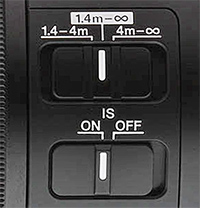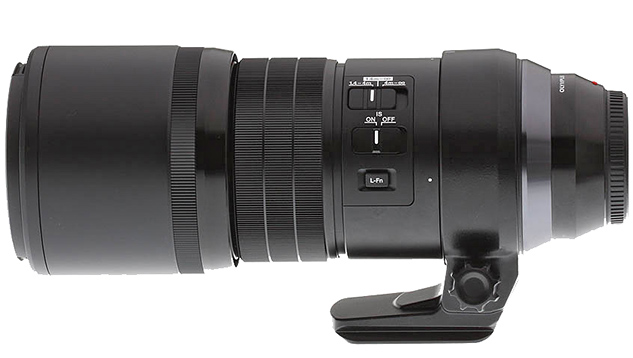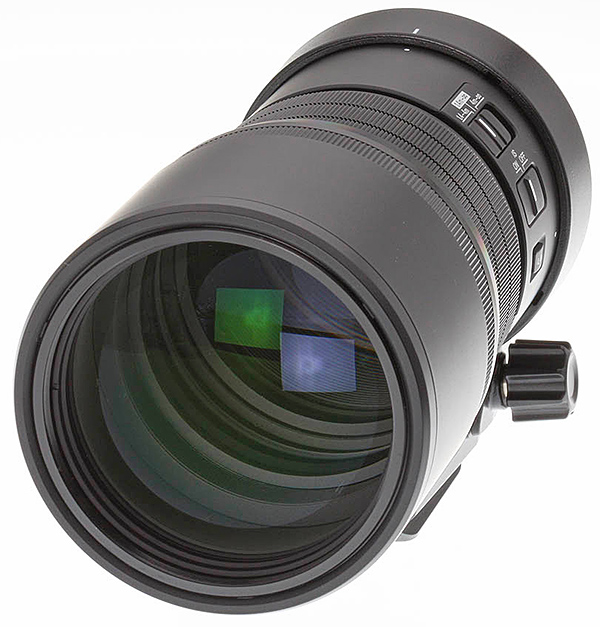Reviewed: The Olympus 300mm f/4 M.Zuiko Pro is here, and it’s packing 6 stops of onboard I.S.!
posted Tuesday, January 5, 2016 at 10:00 PM EST

For all of you Micro Four Thirds photographers waiting for a long, fast prime lens for sports and wildlife shooting, that wait is now over with the official announcement of the Olympus 300mm f/4 M.Zuiko Pro lens. Our friends at Olympus were kind enough to send us an early sample unit for testing in both lab and real world settings, and we've been working rigorously ever since to bring you as much analysis and sample images as possible!
The existence of this lens was unveiled in a development announcement almost a year ago, but little was known about the particulars until recently. We were told it would be weather resistant like all other M.Zuiko Pro lenses and follow a similar sleek, black styling, but what was only recently unveiled to us was an even more exciting spec: namely that it's the first Olympus lens to have image stabilization onboard.

With this 600mm-equivalent offering, Olympus now joins the ranks of Sony and Panasonic in providing a hybrid image stabilization system incorporating I.S. in both the lens and camera body working in unison. With longer focal lengths requiring more in the way of stabiilization while handheld, this lens is indeed a great place to start for diving into the hybrid I.S. landscape.
The tandem "wow factor" of the 300mm f/4 is its size, which is downright diminuitive compared to 600mm-eq. offerings from its current DSLR competitors. Combining the small size of the lens and accompanying mirrorless bodies with the onboard I.S. and fast aperture, you can quickly imagine why we were so excited to get this one into our hands for some real-world shooting paired up with the E-M1! (In truth, the lab had to nag us to get it back in for testing.)
For any of you who'd like to begin your 300mm f/4 exploration with our detailed lens review, please dive in here to see the amazing results provided by our senior lens technician Rob Murray, and our review and analysis from lens expert William Brawley. We'll also provide a link to the full review at the bottom of this page, so for our initial hands' on report, please read on!
Weaning off tripod dependency
I was excited when the technical specialists at Olympus described the handheld capabilities of the 300mm f/4 to us in a briefing, but I still found myself shaking my head. How could they wrangle 6 stops of I.S. into this camera and lens combination? We were told the lens itself is capable of 4-stops of correction, even without the assist from the camera body, which is also quite a neat feat at this size. I decided right then that our initial real world shots should all be sans tripod... shooting from the hip as it were and seeing where the chips would fall.
(Images have been resized to fit this page and slightly adjusted in post, primarily to balance shadows and highlights. Clicking any image will take you to a carrier page where you can access the full resolution image as delivered straight from the Olympus E-M1.)
An aperture of f/4 is certainly quite bright for a 600mm lens, but it's still only half as bright as an f/2.8 sports zoom, so the fast shutter speed potential can be compromised depending on the available light. This is why those 6 stops of I.S. are so alluring, because if you're trekking around the wilds during magic hour and find yourself poised for the perfect shot of a gorgeous animal, it's great to be able to aim and fire without fooling with the tripod nor give too much concern for shutter speeds in order to avoid blur from shaky hands.
That being said, having 6-stops of I.S. when using a compatible camera* allows you to shoot comfortably and steadily with some remarkably slow shutter speeds given the lens' focal length -- think 1/15s based on our testing. Yes, you can shoot with shutter speeds that slow! While the I.S. system will soak up camera shake, you should be aware that shutter speeds might dip slow enough to cause blurring if your subject happens to move.
(*5-axis Sync IS is currently available onboard the E-M1 and E-M5 Mark II with the latest v4.0 and v2.0 firmware updates, respectively.)
My steadiness is about average I'd say -- not too bad, but not rock-solid like our senior lens technician Rob, so these shots will give you an average read on the I.S. potential across a variety of shutter speeds and subject matter for an initial glance.
Why is the image stabilization system, dubbed 5-axis Sync IS, with the new Olympus 300mm f/4 Pro so impressive? According to Olympus, one of the main factors -- in addition to new I.S. algorithms -- is the hand-selected, high-performance gyro sensor inside the lens. Not only did Olympus contract specifically for high-performance gyro sensors, but also each gyro undergoes performance assessments in the factory. Then, Olympus themselves hand-select the best-performing sensors to go into each 300mm lens. In other words, only the best of the best make the cut for the Olympus 300mm f/4 Pro lens. Furthermore, each time the camera is powered-on, the in-camera IS gyro sensor and the lens's counterpart are calibrated against each other.
The full review will provide you with much more technical information regarding the actual measured I.S. in the lab as well as additional data regarding sharpness, distortion, etc.
And for lower light potential such as the concert image above and a few more down below, our publisher Dave Etchells carried the lens with him to the Consumer Electronics Show in Las Vegas and captured a sampling at slower shutter speeds in challenging indoor lighting. At these speeds you're fighting not only camera shake but also the limits of blurring due to moving subjects. Still, it's amazing to see images shot at or near 1/30s handheld with a 600mm eq. lens that are still reasonably crisp!
For many more images with the Olympus 300mm f/4 paired with the E-M1 please visit our Olympus E-M1 gallery page and look for images with "300mm" in the filename. And for much more on the technical nature of this lens please see our full review!

Of course, this technology, performance and build quality do come with a cost, and the Olympus 300mm f/4 Pro IS lens comes in at an estimated street price $2,499.99 (U.S.) and $3,299.99 (Canada). However, compared to competing 600mm lenses for a DSLR, the Olympus seems a definite bargain in both price and size.
Olympus 300mm f/4 Pro Lens Review • Olympus E-M1 Gallery
Ready to pre-order? : B&H • Adorama









